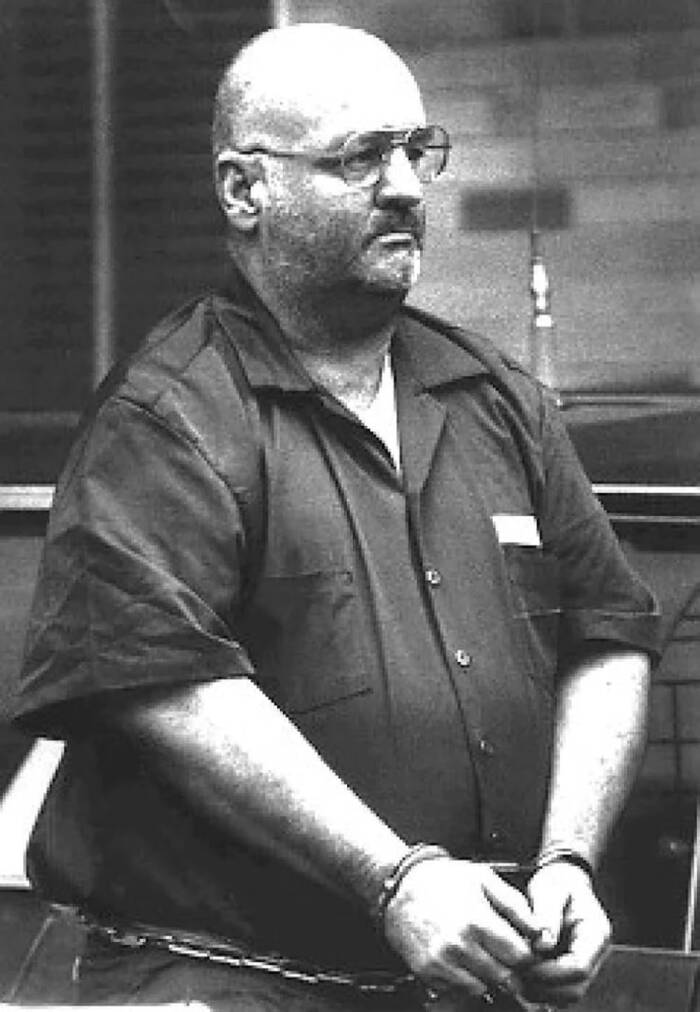In 1972, Arthur Shawcross confessed to killing two children in Watertown, New York. Though he was sentenced to 25 years in prison, he only served 15 — and he soon started killing again.

IMDbThe notorious Genesee River Killer, Arthur Shawcross.
From an early age, Arthur Shawcross had a disturbing propensity for violence. He was known as a bully in his youth who got a kick out of setting fires. Eventually, this troubling behavior would lead to murder.
In 1972, when he was in his late 20s, Shawcross brutally killed two children in Watertown, New York. He would serve about 15 years in prison after his arrest, but a stroke of luck allowed him to return to society.
Chillingly, it wasn’t long before he struck again. Between 1988 and 1990, Shawcross murdered at least 12 women in the Rochester, New York area. His crimes were brutal and merciless, earning him the nickname “Genesee River Killer,” but his obsession with the murders would eventually be his downfall.
This is the horrific story of Arthur Shawcross.
The Early Life Of Arthur Shawcross

Gannett Rochester NewspapersA school photo of a young Arthur Shawcross (top row, fourth from the left).
Arthur John Shawcross was born on June 6, 1945, in Kittery, Maine. He was one of four children of Arthur Roy Shawcross and Elizabeth Yerakes Shawcross. In his youth, his family moved to Watertown, New York.
Like many other future killers, Shawcross claimed that his childhood was traumatic. According to him, his mother and his aunt sexually abused him when he was a child. He also claimed to have had an incestuous relationship with his sister. Shawcross said that he had his first gay encounter at age 11, after which he allegedly experimented with bestiality.
However, the Shawcross family adamantly denies these claims and insists that he had a normal childhood. Whether his accounts are legitimate or a product of his imagination is unclear, but he apparently relied on them to explain why he committed such heinous acts later in his life.
At school, he was known to be a bully with violent tendencies, and he dropped out of high school after he was unable to pass the ninth grade.
In December 1963, Shawcross’ first notable run-in with the law occurred after he smashed a shop window. A year later, Shawcross married a woman named Sarah. The couple had a son in October 1965, and only a month later, they divorced (possibly due to Shawcross’ continued criminal activity).
Shawcross was drafted into the U.S. Army in 1967, and he served a tour of duty during the Vietnam War. He would later boast of having a high “combat kill” count and cannibalizing Vietnamese children while he was there. But records show that Shawcross never even saw combat, and there’s no evidence that he ever cannibalized anyone in Vietnam.
Upon his return to Watertown in 1968, Arthur Shawcross immediately fell back into his violent ways, eventually escalating to murder.
The Murders Of Jack Blake And Karen Hill

Public DomainJack Blake, the first victim of Arthur Shawcross.
Following a failed second marriage and a prison sentence for an arson attack, Arthur Shawcross murdered his first victim, 10-year-old Jack Blake, during the spring of 1972. The boy had been Shawcross’ neighbor in Watertown, and the two were known to have gone fishing together.
Shawcross sexually assaulted and suffocated the young boy before leaving his body in the woods. Jack’s parents reported him missing when he failed to come home, but it was months before his remains were found.
Later that year, Shawcross raped and killed eight-year-old Karen Hill in September. Soon afterward, the police found her body under a bridge.
Unfortunately for Shawcross, witnesses had seen him speaking with the young girl prior to the murder. Because of this, authorities quickly identified Shawcross as a suspect and arrested him in October.

Democrat & ChronicleArthur Shawcross being arrested in Watertown, New York.
Shawcross eventually confessed to the murders of both Karen and Jack. Because of the lack of evidence tying him to Jack’s murder, Shawcross only faced charges for the murder of Karen. He pleaded guilty in exchange for a first-degree manslaughter charge and was sentenced to 25 years in prison.
Shockingly, he was released much earlier than expected.
Arthur Shawcross Becomes The Notorious Genesee River Killer

YouTubeThe known victims of Arthur Shawcross.
In April 1987, after serving about 15 years of his prison sentence, Arthur Shawcross was released. Prison staff members apparently felt like he was no longer a threat to society, despite psychologists reportedly warning against the decision to free him. In retrospect, the decision was criticized.
“I can’t conceive that a man with his background could have been released,” Christopher J. Mega, a chairman for New York’s State Senate Committee on Crime and Corrections, told The New York Times in 1990.
Upon his release, Shawcross faced difficulties finding a stable place to live and work. Understandably, no one wanted to hire him, and his hometown of Watertown was not willing to welcome back a confessed child murderer.
Shawcross eventually settled in Rochester, New York in 1987. And by the spring of 1988, Shawcross had started killing once again.

Wikimedia Commons/CC BY-SA 4.0The Genesee River, where Arthur Shawcross dumped many of his victims.
His first victim after his release was 27-year-old Dorothy Blackburn, a sex worker based in Rochester. She disappeared on March 18, 1988, and her body was found in the Genesee River days later on March 24, 1988.
On July 9, 1988, Shawcross struck again, this time asphyxiating 28-year-old Anna Steffen. Like Blackburn, Steffen was also a sex worker.
Shawcross then murdered a 59-year-old homeless woman named Dorothy Keeler, shortly after she disappeared on July 29, 1989. Shawcross later claimed that Keeler had been his secret “mistress,” and she was allegedly threatening to tell his (fourth) wife about their relationship.
On September 29, 1989, 25-year-old Patricia Ives disappeared. She too was a sex worker. According to Shawcross, the two had consensual sex before Ives tried to steal his wallet. In a rage, he raped and strangled her before leaving her body at a construction site. Her case catapulted the Genesee River Killer into the public eye since her body was found so close to Keeler’s.
The Genesee River Killer Stirs Up Media Coverage

World History Archive/Alamy Stock PhotoTo this day, Arthur Shawcross remains one of the most notorious serial killers to ever stalk Rochester.
After police discovered Patricia Ives’ body on October 27, 1989, they realized that they likely had a serial killer on their hands. Many of the victims were sex workers who had been asphyxiated near the Genesee River. And chillingly, the murderer had attempted to hide the bodies in similar ways.
Soon, the perpetrator became known as the Genesee River Killer in the media. Despite the increased news coverage, however, Arthur Shawcross did not slow down his brutal crime spree. Instead, he escalated — and he would go on to murder at least eight more women in the Rochester area.
Meanwhile, Shawcross’ criminal record had been sealed so his presence wouldn’t alarm people in Rochester, so he didn’t attract attention from the police at first. This would prove disastrous for the women of Rochester.
On October 23, 1989, 30-year-old June Stott vanished, and her remains were found about a month later. Unlike many of the other victims, Stott was not a sex worker. And Shawcross’ attack on her was especially brutal — he strangled her before mutilating her genitals and allegedly eating them.
His next victims were 22-year-old Marie Welch, 22-year-old Frances Brown, 30-year-old Kimberly Logan, 29-year-old Elizabeth Gibson, 32-year-old Darlene Trippi, 33-year-old June Cicero, and 20-year-old Felicia Stephens.
On January 2, 1990, a search helicopter looking for victims in the remote areas near Genesee River spotted the body of June Cicero and a man standing next to a van on a bridge in the vicinity. The man appeared to be pleasuring himself, confirming an earlier police theory that the killer would likely achieve sexual satisfaction by returning to his crime scenes.
Police cars tracked down the van, eventually catching up with it. Inside, Arthur Shawcross surrendered and submitted himself to questioning.
At first, Shawcross refused to admit to the crimes. But then, Rochester police revealed that they knew Clara Neal, Shawcross’ mistress at the time, had a piece of jewelry that once belonged to June Cicero. If he didn’t confess, the police threatened to implicate Neal in the crimes.
Finally, Shawcross admitted to a majority of the murders. In an 80-page-long transcript of his confession, Shawcross claimed that he killed many of the victims after they tried to rob, insult, or physically hurt him.
The excuses did not make any difference. Police had finally found the Genesee River Killer, and the heavy hand of justice was coming for him.
A Killer Faces Justice For His Brutal Crimes

The Ithaca JournalThe Ithaca Journal reports on Arthur Shawcross’ arrest.
In November 1990, Arthur Shawcross went on trial for 10 murders that occurred in Monroe County. Since Elizabeth Gibson was killed in a different county, her trial would be separate from the others. (And one of Shawcross’ 12 known murders was not officially ascribed to him.)
The defense team argued that Shawcross was insane, pointing out his allegedly traumatic childhood, the PTSD he purportedly suffered after his military service, and the fact that he had an extra Y chromosome (which some claim can make a person more violent, though this is only a theory).
One forensic psychiatrist, Dr. Dorothy Lewis, argued that Shawcross had a violent alter ego named Bessie (which was his mother’s nickname). Other forensic psychiatrists, like Dr. Park Dietz, disagreed, calling Shawcross’ alleged multiple personality disorder a “hoax,” according to Oxygen.
In the end, Shawcross was found sane — and guilty of murder — and sentenced to 250 years in prison. During the trial for Elizabeth Gibson’s murder, Shawcross pleaded guilty and received another life sentence.

Public DomainArthur Shawcross with his daughter and granddaughter at the Sullivan Correctional Facility in New York in 2002.
Arthur Shawcross spent the remainder of his life at the Sullivan Correctional Facility in New York. During his incarceration, he would agree to various interviews and discuss his crimes, never once showing remorse.
On November 10, 2008, 63-year-old Shawcross complained of pain in his leg and was transferred to a medical facility. He soon suffered from cardiac arrest and died that day. Just like that, the Genesee River Killer was gone.
Now that you’ve read about Arthur Shawcross, the Genesee River Killer, learn about serial killer Edmund Kemper, whose story is almost too gross to be real. Then, take a look at some other notorious serial killers from history.





